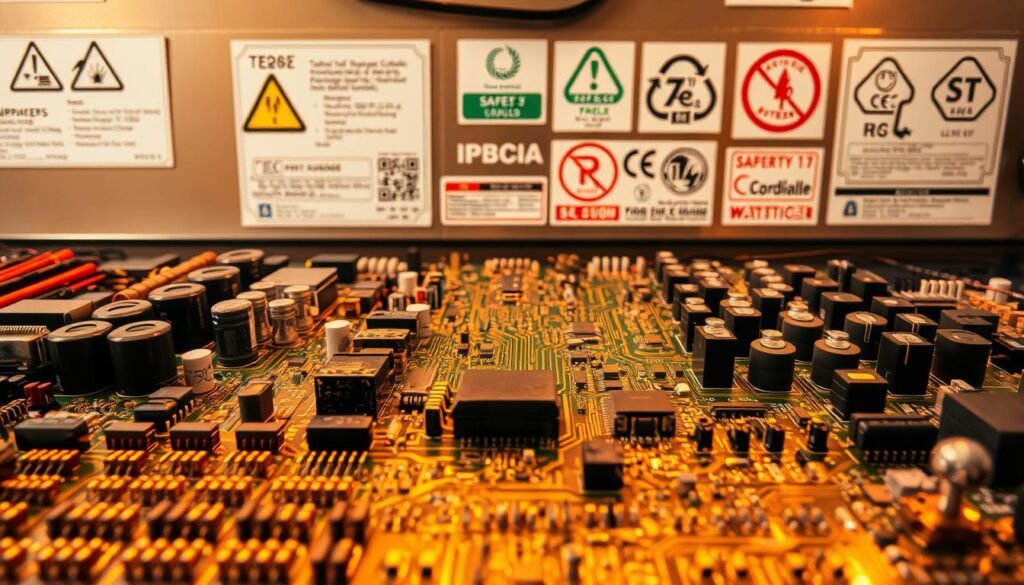What if a single undocumented resistor could cost your company millions? In an era where printed circuit boards power everything from medical devices to smart home systems, visibility into production processes isn’t optional—it’s survival.
We’ve all encountered devices that fail unexpectedly. Behind these failures often lies a hidden culprit: incomplete tracking of components during fabrication. Modern electronics rely on intricate networks of conductive pathways, assembled under extreme conditions like high-temperature soldering or chemical treatments. These processes test both materials and methods.
As boards shrink and complexity grows, traditional oversight methods falter. Consider this: a smartphone’s mainboard contains over 1,000 components sourced globally. Without precise tracking systems, identifying defective parts becomes akin to finding needles in a haystack—during a product recall.
This guide unpacks how leading manufacturers maintain control over their production ecosystems. We’ll explore strategies that transform chaotic workflows into mapped journeys for every capacitor, IC chip, and connector.
Key Takeaways
- Printed circuit boards form the operational core of modern tech, requiring flawless execution across production stages
- Harsh manufacturing environments demand resilient tracking solutions that withstand thermal and chemical stresses
- Component-level monitoring enables rapid defect identification and targeted recalls
- Miniaturization trends intensify the need for advanced data capture technologies
- Effective tracking systems impact regulatory compliance, brand reputation, and customer trust
Understanding PCB Traceability: Fundamentals and Importance
The true backbone of electronic reliability isn’t just silicon and solder—it’s data. Modern boards carry more than electrical signals; they embed their entire production story into scannable markers and digital records.
Defining Documentation Systems for Circuit Boards
We view pcb traceability as a forensic-level recording method. It logs every material batch, machine setting, and environmental condition during fabrication. Copper suppliers, solder application times, and even workstation humidity levels become part of this permanent record.
Key identifiers form the system’s foundation:
- Unique serial codes for individual boards
- Supplier certifications for raw materials
- Timestamps tracking each assembly phase
Operational Advantages in Safety Protocols
When a thermal sensor fails in medical equipment, manufacturers need answers—fast. Advanced tracking allows teams to:
- Locate all boards using a specific capacitor batch in 43 seconds
- Analyze production conditions for failed components
- Update testing protocols using historical performance data
“You can’t improve what you can’t measure—and you can’t protect what you don’t track.”
This bidirectional visibility transforms quality assurance. Teams trace components forward to shipped products or backward to root causes, turning potential disasters into controlled corrections.
Traceability in PCBA Manufacturing: Why It’s Important for Quality, Recall

Imagine a cardiac monitor failing during surgery. Within minutes, teams trace the malfunction to a specific capacitor batch using digital production records. This isn’t fiction—it’s modern quality control in action.
Pinpointing Flaws Before They Escalate
Advanced tracking systems act as manufacturing X-rays. They reveal hidden patterns through:
- Component-level timestamping
- Machine calibration logs
- Operator verification checkpoints
When a medical device maker found intermittent connection issues, their system identified a solder paste application error from 11 months prior. Root cause analysis took hours instead of weeks.
Legal Shields in High-Stakes Industries
Comprehensive documentation protects manufacturers when regulators come knocking. We’ve seen aerospace suppliers:
- Verify component origins during FAA audits
- Limit recall scope to 142 units instead of 14,000
- Demonstrate safety protocols exceeded ISO standards
“Our tracking data settled a $3M liability case in 48 hours.” – Defense contractor QA director
These systems don’t just find problems—they prevent them. By analyzing historical data, teams spot material degradation trends before field failures occur. This proactive compliance approach transforms risk management from reactive firefighting to strategic foresight.
Technical Solutions and Innovations in PCB Traceability
Modern electronics demand identification systems as advanced as the components they track. We implement solutions that survive solder reflow ovens and chemical baths while delivering instant data accessibility.
Evolution of Machine-Readable Identifiers
Traditional barcodes laid the foundation, but today’s printed circuit boards require smarter solutions. QR codes store 100x more data than standard barcodes, while data matrix codes pack details into spaces smaller than a grain of rice.
| Technology | Data Capacity | Durability | Line-of-Sight |
|---|---|---|---|
| Barcode | 20 characters | Moderate | Required |
| QR Code | 7,089 characters | High | Required |
| RFID | Unlimited* | Extreme | Not needed |
| Laser Mark | Custom | Permanent | Required |
Smart Tracking in Harsh Environments
RFID tags embedded in substrates withstand temperatures exceeding 300°C. Laser-etched serial numbers remain legible after thermal cycling tests. These methods enable:
- Automatic component verification during assembly
- Real-time production flow monitoring
- Post-manufacturing quality audits
“Our RFID implementation reduced component verification time by 83%.” – Automotive electronics QA manager
Seamless Production Line Integration
Surface-mount technology (SMT) lines now handle identification labels like standard components. Polyimide tags withstand soldering processes while maintaining crisp scannability. Precision placement ensures:
- Consistent label positioning across batches
- Zero interference with circuit functionality
- Automated data capture throughout manufacturing
Ensuring Compliance, Safety, and Quality Control

How do manufacturers prove their products meet life-saving specifications? Rigorous tracking systems create an unbroken chain of evidence from design to delivery. This digital paper trail transforms regulatory hurdles into competitive advantages.
Meeting Industry Standards and Regulatory Requirements
Global certifications like ISO 13485 (medical devices) and DO-178C (aerospace) demand more than checklists. They require verifiable proof of component origins and production conditions. We implement systems that:
- Automatically map design specifications to test results
- Flag deviations from approved material sources
- Generate audit-ready reports in FDA/ISO formats
A recent automotive client reduced certification time by 40% using automated compliance checking during PCB design. Their system now validates 212 safety requirements in real-time.
Implementing Effective Quality Assurance Measures
Advanced tracking enables proactive defect prevention. One medical device maker discovered a solder paste viscosity issue through historical process data—before field failures occurred. Their solution:
- Implemented machine learning analysis of production records
- Created automated alerts for parameter drift
- Reduced rework costs by $217k annually
“Our quality teams now spend 70% less time preparing audit documentation.” – Aerospace components QA lead
Modern systems don’t just record data—they turn it into actionable insights. Real-time dashboards show compliance status across all active projects, while predictive analytics identify potential risks before they impact production.
Enhancing Production Efficiency through Traceability Integration
Smart factories thrive on synchronized workflows where every machine speaks the same data language. By weaving traceability into production ecosystems, manufacturers unlock real-time decision-making capabilities that reshape operational outcomes.
Real-time Data Capture on the Production Line
Modern assembly lines generate terabytes of operational data daily. Integrated tracking systems transform this raw information into actionable insights through:
- IoT sensors monitoring component placement accuracy
- Automated quality checks during solder paste application
- Instant alerts for parameter deviations
One automotive supplier reduced material waste by 18% using live dashboards showing exact solder consumption per PCB. Their system automatically adjusts dispensing machines when usage patterns shift.
Streamlining Assembly and Maintenance Processes
Traceability data flows seamlessly from design files to repair stations. Technicians accessing advanced traceability solutions can:
- Identify faulty capacitors using batch-specific thermal profiles
- Access original assembly torque specifications
- Predict replacement schedules using component lifespan data
A medical device maker slashed maintenance downtime by 65% after implementing QR-code-based service manuals. Scanners pull up schematics showing exact component locations in complex multi-layer boards.
“Our adaptive production lines now auto-adjust to component shortages – we reroute workflows before humans notice the gap.”
Machine learning algorithms analyze years of production cycle data to optimize workflows. These systems suggest layout changes reducing robotic arm movement by 22%, accelerating throughput without hardware upgrades.
Data Management, Analytics, and Process Improvement
What separates top-tier manufacturers from competitors? The answer flows through their data pipelines. Modern production ecosystems generate mountains of operational intelligence – but only organized systems turn noise into actionable strategy.
Leveraging Traceability Software for Process Optimization
Advanced traceability software acts as a central nervous system for production. These platforms automatically map relationships between design specs, component batches, and test results. When engineers update a resistor value, connected documentation and assembly instructions refresh globally.
One medical device company reduced time-to-market by 31% using real-time update features. Their system now:
- Flags conflicting requirements during design reviews
- Auto-generates compliance reports for FDA audits
- Predicts material shortages using machine learning
Utilizing Data Analytics to Drive Product Improvements
Raw production numbers transform into gold when analyzed properly. We’ve seen manufacturers:
- Identify solder paste viscosity trends across 18-month periods
- Correlate robotic placement speed with defect rates
- Optimize thermal profiles using component failure histories
“Our analytics dashboard revealed a 0.2-second machine delay causing 14% rework – fixed in one afternoon.”
These insights fuel smarter product development. A recent automotive project used warranty claim patterns to redesign connector seals, cutting field failures by 62%. Production efficiency gains compound when teams base decisions on historical evidence rather than hunches.
AI-powered systems take this further, scanning requirements documents for vague language before prototyping begins. One aerospace supplier avoided $410k in scrap costs by catching ambiguous torque specifications early.
Conclusion
Behind every reliable device lies a meticulously documented journey from factory to fingertips. Modern production demands systems that track components across global supply chains while surviving extreme assembly conditions. These digital trails transform risk management into strategic advantage.
We implement solutions where data integrity matches circuit precision. By embedding tracking into every production phase, teams gain:
- Instant access to material origins and test results
- Automated compliance reporting for regulatory audits
- Predictive analytics identifying process deviations
Integrating advanced traceability solutions with enterprise systems creates ripple effects beyond assembly lines. Manufacturers achieve 37% faster defect resolution while strengthening customer confidence through verifiable quality histories.
The future belongs to organizations treating component histories as valuable assets. As devices grow smarter, their creation stories must remain equally transparent. Start building your unbroken chain of evidence today – before a single undocumented resistor writes tomorrow’s crisis report.
FAQ
How does component tracking impact product reliability?
What technologies enable effective supply chain visibility?
Can trace systems reduce recall costs?
Why is material history critical for medical devices?
How do aerospace manufacturers benefit from serialized tracking?
Does implementing tracking slow down production?
What data analytics come from trace systems?
How does tracking support sustainability goals?
About The Author
Elena Tang
Hi, I’m Elena Tang, founder of ESPCBA. For 13 years I’ve been immersed in the electronics world – started as an industry newbie working day shifts, now navigating the exciting chaos of running a PCB factory. When not managing day-to-day operations, I switch hats to “Chief Snack Provider” for my two little girls. Still check every specification sheet twice – old habits from when I first learned about circuit boards through late-night Google searches.
